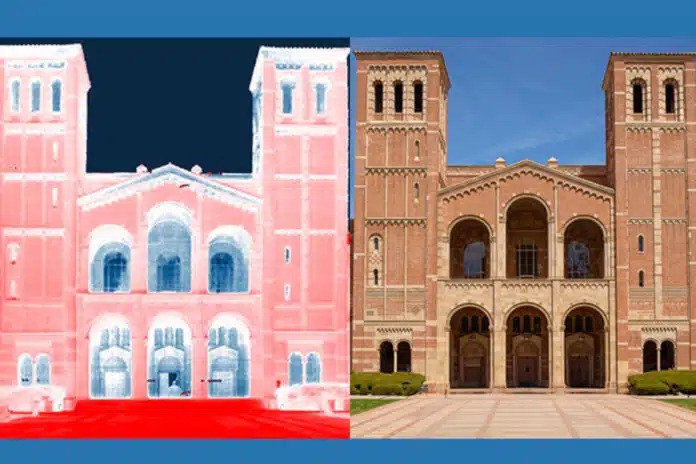Wednesday, 16/10/2024 | 17:27 GMT+7
A team led by Aaswath Raman, an associate professor of materials science and engineering at the UCLA Samueli School of Engineering, recently published a study in Cell Reports Physical Science outlining a novel approach to controlling the flow of radiant heat through common building materials to enhance thermal management.

A Royce Hall thermal infrared image reveals radiant heat. The facade absorbs heat (white to pale red) from the ground (red) while some heat from the ground/building radiates up to the cold sky (blue).
Radiant heat, which is experienced when a warm surface heats our bodies and living spaces through electromagnetic waves, spans the entire spectrum at ground level between buildings and their surroundings.
However, heat exchange between buildings and the sky occurs primarily within a narrower band of the infrared spectrum, known as the atmospheric transmission window. This discrepancy in radiant heat transfer has historically posed challenges for cooling buildings with limited skyward-facing surfaces. Such buildings tend to retain heat from the ground and adjacent walls in hot weather, making cooling difficult. Similarly, they struggle to retain warmth in the winter as outdoor temperatures drop and the buildings lose heat.
“If we look at historical cities like Santorini in Greece or Jodhpur in India, we find that cooling buildings by making roofs and walls reflect sunlight has been practiced for centuries,” said Raman, who leads the Raman Lab at UCLA Samueli. “In recent years, there has been massive interest in cool roof coatings that reflect sunlight. But cooling walls and windows is a much more subtle and complex challenge.”
The researchers embarked on a mission to replicate the success of cooling buildings with super white paint by developing materials that could passively manage heat movement between buildings and their surroundings. By coating walls and windows with these innovative materials, they showcased the ability to keep buildings cooler in summer and warmer in winter, offering a promising solution for more energy-efficient and comfortable spaces.
A thermal infrared image capturing heat movement between buildings in Los Angeles. Credit: Raman Lab/UCLA
“We were particularly excited when we found that materials like polypropylene, which we sourced from household plastics, can selectively radiate or absorb heat in the atmospheric window very effectively,” Raman said. “These materials border on the mundane, but the same scalability that makes them common also means that we could see them thermoregulating buildings in the near future.”
The team’s innovative approach not only utilizes cost-saving materials but also helps conserve energy by reducing the need for air conditioning and heating. This not only saves money but also reduces carbon dioxide emissions.
“The mechanism we proposed is completely passive, which makes it a sustainable way to cool and heat buildings with the seasons and yield untapped energy savings,” said Jyotirmoy Mandal, the study’s first author and a former postdoctoral scholar in Raman’s lab. Mandal is now a civil and environmental engineering assistant professor at Princeton University.
The researchers believe this new method can be easily scaled and will significantly impact low-income communities with limited or no access to cooling and heating systems, particularly those affected by extreme weather events.
According to Techexplorist

.jpg?w=367&h=206&mode=crop)






 Launching "Accelerating Innovative Startups for Energy Efficiency Competition"
Launching "Accelerating Innovative Startups for Energy Efficiency Competition"
 National Conference on Energy Efficiency and Conservation 2024
National Conference on Energy Efficiency and Conservation 2024
 Consultation on Draft catalogues and guidelines for energy efficiency technology in industries
Consultation on Draft catalogues and guidelines for energy efficiency technology in industries
 Sustainable production and energy saving at the brewery
Sustainable production and energy saving at the brewery
 Promoting the Energy Efficiency Investment Market in the Industrial Sector
Promoting the Energy Efficiency Investment Market in the Industrial Sector
 Energy Savings from Technical Solutions to Human Efforts
Energy Savings from Technical Solutions to Human Efforts
 Indonesia aims to reduce emissions through building industry
Indonesia aims to reduce emissions through building industry